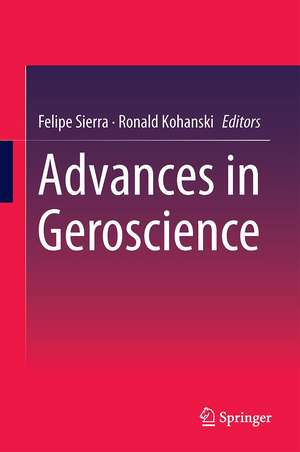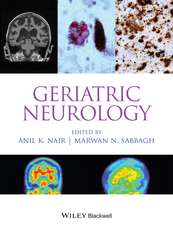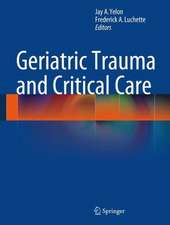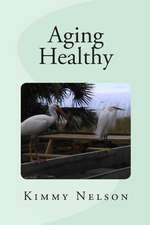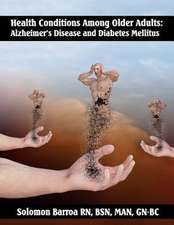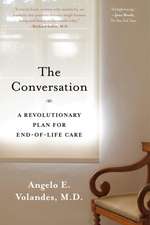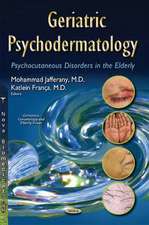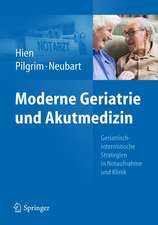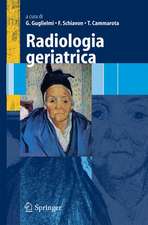Advances in Geroscience
Editat de Felipe Sierra, Ronald Kohanskien Limba Engleză Hardback – 20 noi 2015
The book begins with an analysis of the Geroscience hypothesis, as well as the epidemiological underpinnings that define aging as a candidate main risk factor for most chronic diseases. Next, each chapter focuses on one particular disease, or group of diseases, with an emphasis on how basic molecular and cellular biology might explain why aging is a major risk factor for it. Coverage in the book includes: cancer, cardiovascular disease, dementias, stroke, Parkinson's and Alzheimer’s diseases, osteoporosis, arthritis, diabetes asthma, emphysema, kidney disease, vision impairment, and AIDS/HIV. It finishes with a chapter on pain in the elderly and an overview of future steps needed to bring the newly acquired knowledge into the clinic and the public at large.
| Toate formatele și edițiile | Preț | Express |
|---|---|---|
| Paperback (1) | 1113.46 lei 6-8 săpt. | |
| Springer International Publishing – 23 aug 2016 | 1113.46 lei 6-8 săpt. | |
| Hardback (1) | 1120.76 lei 6-8 săpt. | |
| Springer International Publishing – 20 noi 2015 | 1120.76 lei 6-8 săpt. |
Preț: 1120.76 lei
Preț vechi: 1179.75 lei
-5% Nou
Puncte Express: 1681
Preț estimativ în valută:
214.45€ • 224.51$ • 177.45£
214.45€ • 224.51$ • 177.45£
Carte tipărită la comandă
Livrare economică 05-19 aprilie
Preluare comenzi: 021 569.72.76
Specificații
ISBN-13: 9783319232454
ISBN-10: 3319232452
Pagini: 622
Ilustrații: XXIII, 622 p. 39 illus.
Dimensiuni: 155 x 235 x 40 mm
Greutate: 1.08 kg
Ediția:1st ed. 2016
Editura: Springer International Publishing
Colecția Springer
Locul publicării:Cham, Switzerland
ISBN-10: 3319232452
Pagini: 622
Ilustrații: XXIII, 622 p. 39 illus.
Dimensiuni: 155 x 235 x 40 mm
Greutate: 1.08 kg
Ediția:1st ed. 2016
Editura: Springer International Publishing
Colecția Springer
Locul publicării:Cham, Switzerland
Public țintă
ResearchCuprins
The Geroscience Hypothesis: Is It Possible to Change the Rate of Aging?: Steven N. Austad.- Etiological Role of Aging in Chronic Diseases: From Epidemiological Evidence to the New Geroscience: Linda P. Fried and Luigi Ferrucci.- The Impact of Aging on Cancer Progression and Treatment: Shenghui He and Norman E. Sharpless.- The Impact of Cancer Treatments on Aging: Changhan Lee and Valter Longo.- Cardiovascular Disease and Aging: Ying Ann Chiao, Edward Lakatta, Zoltan Ungvari, Dao-Fu Dai and Peter Rabinovitch.- The Impact of Aging on Ischemic Stroke: Farida Sohrabji.- Parkinson’s Disease and Aging: Julie K. Andersen.- The Role of Aging in Alzheimer’s Disease: Geoffrey A. Kerchner and Tony Wyss-Coray.- Aging and the Bone-Muscle Interface: Simon Melov and Clifford J. Rosen.- Osteoporosis and Mechanisms of Skeletal Aging: Julie Glowacki and Tamara Vokes.- Osteoarthritis in the Elderly: Richard F. Loeser and Martin Lotz.- Diabetes and Aging: Nicolas Musi and Andrzej Bartke.- Renal Aging and Transplantation: John P. Higgins and Stuart K. Kim.- Asthma and Aging: Nicola A. Hanania and Paula Busse.- Aging in COPD and Idiopathic Pulmonary Fibrosis: Cecilia Sanchez.- Age-Related Macular Degeneration and Vision Impairment: Jayakrishna Ambati and Charles Wright.- HIV and Aging: Parallels and Synergistic Mechanisms Leading to Premature Disease and Functional Decline: Anna Hearps, Katherine Schafer, Kevin High and Alan Landay.- Pain in the Elderly: Roger B. Fillingim, Dennis C. Turk and Robert P. Yezierski.- The Way Forward: Translation: James L. Kirkland.
Textul de pe ultima copertă
This book provides the first comprehensive overview of a new scientific discipline termed Geroscience. Geroscience examines the molecular and cellular mechanisms that might explain why aging is the main risk factor for most chronic diseases affecting the elderly population. Over the past few decades, researchers have made impressive progress in understanding the genetics, biology and physiology of aging. This book presents vital research that can help readers to better understand how aging is a critical malleable risk factor in most chronic diseases, which, in turn, could lead to interventions that can help increase a healthy lifespan, or ‘healthspan.’
The book begins with an analysis of the Geroscience hypothesis, as well as the epidemiological underpinnings that define aging as a candidate main risk factor for most chronic diseases. Next, each chapter focuses on one particular disease, or group of diseases, with an emphasis on how basic molecular and cellular biology might explain why aging is a major risk factor for it. Coverage in the book includes: cancer, cardiovascular disease, dementias, stroke, Parkinson's and Alzheimer’s diseases, osteoporosis, arthritis, diabetes asthma, emphysema, kidney disease, vision impairment, and AIDS/HIV. It finishes with a chapter on pain in the elderly and an overview of future steps needed to bring the newly acquired knowledge into the clinic and the public at large.
The book begins with an analysis of the Geroscience hypothesis, as well as the epidemiological underpinnings that define aging as a candidate main risk factor for most chronic diseases. Next, each chapter focuses on one particular disease, or group of diseases, with an emphasis on how basic molecular and cellular biology might explain why aging is a major risk factor for it. Coverage in the book includes: cancer, cardiovascular disease, dementias, stroke, Parkinson's and Alzheimer’s diseases, osteoporosis, arthritis, diabetes asthma, emphysema, kidney disease, vision impairment, and AIDS/HIV. It finishes with a chapter on pain in the elderly and an overview of future steps needed to bring the newly acquired knowledge into the clinic and the public at large.
Caracteristici
Provides a comprehensive overview of the new discipline, geroscience Examines mechanisms and consequences of aging as the main risk factor for most chronic diseases Provides links between aging biology and age-related diseases Provides specific coverage on a wide range of chronic diseases, from both basic and clinical perspectives
